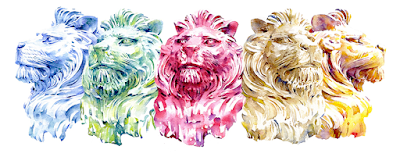中華人民共和國香港特別行政區
Hong Kong Special Administrative Region (HKSAR)
Hong Kong Special Administrative Region (HKSAR)
香港上海滙豐銀行有限公司
The Hongkong and Shanghai Banking Corporation Limited* (HSBC)
The Hongkong and Shanghai Banking Corporation Limited* (HSBC)
Currency : Dollar (HKD)
The city’s rich natural and cultural heritage;-
$20 – Dim sum and tea culture;
$50 – Hong Kong butterflies;
$100 – Cantonese opera;
$500 – Hong Kong UNESCO Global Geopark;
$1000 – International financial Center.
The main feature on the front design on all the notes is the Lion head (Stitt) sculpture which is stationed outside the bank's headquarter in Hong Kong. The lion sculptures have been a distinctive landmark in its own right in Hong Kong, Shanghai and London offices as well. To the local in Hong Kong, HSBC is also sometime referred to as the Lion Bank 獅子銀行, because of the lion sculptures.
There is an interesting story to tell for the two lion sculptures. These two lions are nicknamed after two former employees, namely Alexander Gordan "Stephen" (mouth opened) and Gorden Holmes "Stitt" (mouth closed). The lions were designed by Henry Poole in England in 1921 and shipped to the Shanghai office in 1923. They were so popular among the locals that two more were commissioned for the new Hong Kong head office when it was opened in 1935. "Stephen" was the Chief Manager of Hong Kong and "Stitt" was the Shanghai office manager (Stephen's successor). During the Second World War, these two lions were looted by the Japanese military and shipped to Japan with the intention to use it as scrap metal. Fortunately this did not happen and in 1945, the lions were returned to Hong Kong after they were spotted by an American sailor at the Osaka dockyard. Based on the designs of this series, only "Stitt" is depicted on the front of the notes. "Stitt" (together with "Stephen") first appeared on the HSBC 1972 banknote of $100.
The image of "Stitt" printed on this series is not all the same. If you look at the design, "Stitt" is turning from left to right on each note, turning at a pace of say 45 degrees angle per note, ie starting with 0 degree ($20); 45 degrees ($50); 90 degrees ($100); 135 degrees ($500) and 180 degrees ($1000).
 |
| "Stitt" turning from left to right (courtesy of HSBC) |
$20 – Tea gathering (143mm x 71.5mm);
$50 – Butterfly and flowers (148mm x 74mm);
$100 – Cantonese opera (153mm x 76.5mm);
$500 – Hexagonal rock columns (158mm x 79mm);
$1000 – Financial metropolis (163mm x 81.5mm).
This is the first time in the history of Hong Kong banknotes that the themes on the reverse side of the three note-issuing banks' notes are the same for each denomination, albeit different designs. Out of the three banks that issue banknotes in Hong Kong, for this 2018 series, only the HSBC notes are all printed with the description texts on the back designs, in both Chinese and English.
In a change from the traditional horizontal design, the reverse side of the new banknotes is vertically orientated.
It has been reported that the notes are manufactured with a thin transparent protective layer on it which will prolong the lifespan of the note by up to two more years. In Hong Kong, more than 50% of the circulation of banknotes are issued by HSBC.
Signature : Peter Wong Tung-Shun (Chief Executive)
Twenty Dollars
 |
| Dated 2018, Lion head (Stitt), tea leaves (Dynamic Shimmering Pattern) |
 |
| Reverse - 一家茶敍 Tea Gathering - young child pouring tea for the elder generations (yum cha) |
Fifty Dollars
 |
| Dated 2018, Lion head (Stitt), butterfly (Dynamic Shimmering Pattern) |
 |
| Reverse - 舞蝶花間 Butterfly resting on China Rose Hibiscus flower |
One Hundred Dollars
 |
| Dated 2018, Lion head (Stitt), Yueqin (musical instrument - Dynamic Shimmering Pattern) |
 |
| Reverse - 梨園粵韻 Cantonese Opera - a loving couple meeting in a Chinese garden |
Five Hundreds Dollars
 |
| Dated 2018, Lion head (Stitt), rock columns (Dynamic Shimmering Pattern) |
 |
| Reverse - 六角石柱 Hexagonal Rock Columns at High Island Reservoir East Dam with two hikers, White-bellied Sea Eagles |
One Thousand Dollars
 |
| Dated 2018, Lion head (Stitt), Bauhinia flower (Dynamic Shimmering Pattern) |
 | |
| Reverse - 金融都會 Financial Metropolis (panoramic fisheye view of Hong Kong financial center), Lion Rock background |
Together with the two other major banks (Standard Chartered Bank (Hong Kong) Limited and Bank of China (Hong Kong) Limited) that issue banknotes in Hong Kong, the new HK$1,000 banknotes was issued on 12.12.2018 while the HK$500 entered into circulation on 23.01.2019. The HK$100 was released on 03.09.2019 and the remaining two notes, HK$50 and HK$20 banknotes were made available on 13.01.2020. The existing series of banknotes remains legal tender in Hong Kong and continues to circulate along with the new series.
These notes were printed by Hong Kong Note Printing Limited (HKNPL - 香港印鈔有限公司). The printing plant is located in Tai Po Hong Kong. The Hong Kong Government in 1996 bought the printing plant from De La Rue Group (UK). Since then, the Hong Kong Government holds 55% of the shares in this company. The remaining 45% are owned by China Banknotes Printing and Minting Corporation (15%) and 10% each for the three note-issuing banks in Hong Kong.
Interesting Fact:
When Hong Kong
was under British rule, the spelling of the territory was in one
word i.e. Hongkong. Despite the government changing this to a two-word
name (ie Hong Kong) on 03.09.1926, the bank retained the single word
spelling in it's own name i.e. Hongkong.
Note * - since 1993 the HSBC bank's name has included the word "Limited".
*

No comments:
Post a Comment